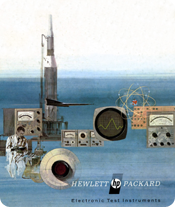

From Simple Analog Voltmeter
to Fast Digital Data Logging System
The 1959 general catalog listed 7 different Voltage, Current, Resistance, Analog Measuring Equipment, and one Digital DC Voltmeter. In the 1970 catalog, AC Voltmeters, DC Volmeters, Multifunction Meters, and Current Meters were a total of 35 different instruments for the Analog category, and 10 instruments for the Digital one. The 1979 catalog still listed 16 different Analog Meters, and the Digital category included more than 10 different instruments to measure Voltage, Current and Resistance.
The current chapter will try to show the evolution of these product lines in the overall Hewlett Packard production during the 1960s and 1970s decades. Needless to say that the technology evolution during these two decades had a considerable impact on product diversification. As usual during this Quick Tour we will choose the most significant devices to illustrate the story. But even limiting references to the most important instruments, we need to clarify and divide the overall product line into five different categories. In respect of the classification of the original Hewlett Packard catalogues, the categories are the following:
- Analog Voltmeter
- Digital Voltmeter
- Data Logger

- Power Meter
- Power Supply
Curator Note:
Hewlett-Packard instrument innovation got organized and really hit its stride in the 1960s. This clearly shows in the remarkably diverse lineup of HP voltmeters and data loggers shown below. There are analog and digital meters, ac and dc meters, average-sensing and rms (root-mean-square) sensing and peak sensing, rf and sampling meters, there are meter movements (the display with the pointer) with fast response and others with "ballistic" damping, there are meters optimized for audio speech wave patterns. There are logarithmic-responding meter movements, a difficult function to achieve. There are super accurate "taut band" meter movements with zero hysteresis, as contrasted to traditional jewel bearings. There are meters and other instrumentation intended for the highest precision environment of the corporate metrology (standards) lab.
This explosion of measurement products was in no small part due to two elements; 1) The U.S. race to put a man on the moon, and 2) The lack of a national metrology system which could deliver measurement assurance to military procurement. Both programs worked in geographically-separated activities, and demanded that one volt measured on the East Coast would be identical to one volt measured on a US Navy ship on the ocean. John Minck was part of that National Measurement System and tells about it in his essay, The Birth of the U.S. Measurement System of the 1960s. HERE.



